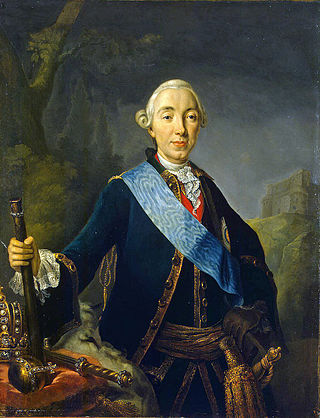
Peter III Fyodorovich was Emperor of Russia from 5 January 1762 until 9 July of the same year, when he was overthrown by his wife, Catherine II. He was born in the German city of Kiel as Charles Peter Ulrich of Schleswig-Holstein-Gottorp, but he was a grandson of Peter the Great and a great-grandson of Charles XI of Sweden.

The Battle of Rossbach took place on 5 November 1757 during the Third Silesian War near the village of Rossbach (Roßbach), in the Electorate of Saxony. It is sometimes called the Battle of, or at, Reichardtswerben, after a different nearby town. In this 90-minute battle, Frederick the Great, king of Prussia, defeated an Allied army composed of French forces augmented by a contingent of the Reichsarmee of the Holy Roman Empire. The French and Imperial army included 41,110 men, opposing a considerably smaller Prussian force of 22,000. Despite overwhelming odds, Frederick managed to defeat the Imperials and the French.

The Pomeranian War was a theatre of the Seven Years' War. The term is used to describe the fighting between Sweden and Prussia between 1757 and 1762 in Swedish Pomerania, Prussian Pomerania, northern Brandenburg and eastern Mecklenburg-Schwerin.

The Kingdom of Prussia constituted the German state of Prussia between 1701 and 1918. It was the driving force behind the unification of Germany in 1866 and was the leading state of the German Empire until its dissolution in 1918. Although it took its name from the region called Prussia, it was based in the Margraviate of Brandenburg. Its capital was Berlin.
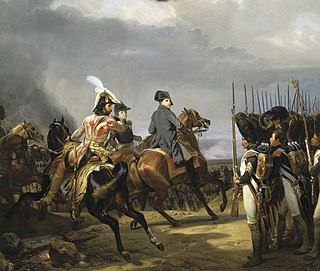
The twin battles of Jena and Auerstedt were fought on 14 October 1806 on the plateau west of the river Saale in today's Germany, between the forces of Napoleon I of France and Frederick William III of Prussia. The defeat suffered by the Prussian Army subjugated the Kingdom of Prussia to the French Empire until the Sixth Coalition was formed in 1813.
The Treaty of Hubertusburg was signed on 15 February 1763 at Hubertusburg Castle by Prussia, Austria and Saxony to end the Third Silesian War. Together with the Treaty of Paris, signed five days earlier, it marked the end of the Seven Years' War. The treaty ended the continental conflict with no significant changes in prewar borders. Austria and Saxony renounced all claims to the Silesian territories ceded to Prussia in the 1742 Treaty of Berlin and the 1745 Treaty of Dresden. Prussia clearly stood among the ranks of the European great powers, while the treaty enhanced the rivalry with Austria.
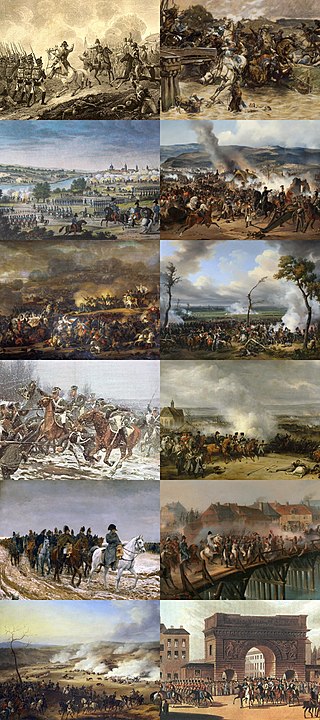
In the War of the Sixth Coalition, sometimes known in Germany as the Wars of Liberation, a coalition of Austria, Prussia, Russia, Spain, Great Britain, Portugal, Sweden, Sardinia, and a number of German States defeated France and drove Napoleon into exile on Elba. After the disastrous French invasion of Russia of 1812 in which they had been forced to support France, Prussia and Austria joined Russia, the United Kingdom, Sweden, and Portugal, and the rebels in Spain who were already at war with France.

The Silesian Wars were three wars fought in the mid-18th century between Prussia and Habsburg Austria for control of the Central European region of Silesia. The First (1740–1742) and Second (1744–1745) Silesian Wars formed parts of the wider War of the Austrian Succession, in which Prussia was a member of a coalition seeking territorial gain at Austria's expense. The Third Silesian War (1756–1763) was a theatre of the global Seven Years' War, in which Austria in turn led a coalition of powers aiming to seize Prussian territory.

The Battle of Kolín (Kolin) on 18 June 1757 saw 54,000 Austrians under Count von Daun defeat 34,000 Prussians under Frederick the Great during the Third Silesian War. Prussian attempts to turn the Austrian right flank turned into piecemeal frontal attacks and were defeated in five and a half hours of combat. The Prussians lost 13,733 men, the Austrians 8,100. Frederick gave up the siege of Prague as well as his planned march on Vienna and retreated to Saxony.

The Battle of Gross-Jägersdorf was a victory for the Russian force under Field Marshal Stepan Fyodorovich Apraksin over a smaller Prussian force commanded by Field Marshal Hans von Lehwaldt, during the Seven Years' War. This was the first battle in which Russia engaged during the Seven Years' War.
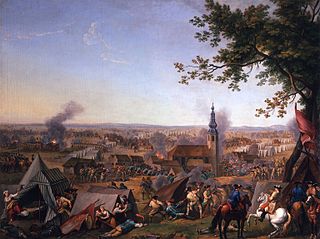
The Battle of Hochkirch took place on 14 October 1758, during the Third Silesian War. After several weeks of maneuvering for position, an Austrian army of 80,000 commanded by Lieutenant Field Marshal Leopold Josef Graf Daun surprised the Prussian army of 30,000–36,000 commanded by Frederick the Great. The Austrian army overwhelmed the Prussians and forced a general retreat. The battle took place in and around the village of Hochkirch, 9 kilometers (6 mi) east of Bautzen, Saxony.

The Battle of Kunersdorf occurred on 12 August 1759 near Kunersdorf immediately east of Frankfurt an der Oder. Part of the Third Silesian War and the wider Seven Years' War, the battle involved over 100,000 men. An Allied army commanded by Pyotr Saltykov and Ernst Gideon von Laudon that included 41,000 Russians and 18,500 Austrians defeated Frederick the Great's army of 50,900 Prussians.

The Battle of Mollwitz was fought by Prussia and Austria on 10 April 1741, during the First Silesian War. It was the first battle of the new Prussian King Frederick II, in which both sides made numerous military blunders and King Frederick II of Prussia fled the battlefield, but the Prussian Army still managed to attain victory. This battle cemented Frederick's authority over the newly conquered territory of Silesia and gave him valuable military experience.

The War of the Bavarian Succession was a dispute between the Austrian Habsburg monarchy and an alliance of Saxony and Prussia over succession to the Electorate of Bavaria after the extinction of the Bavarian branch of the House of Wittelsbach. The Habsburgs sought to acquire Bavaria, and the alliance opposed them, favoring another branch of the Wittelsbachs. Both sides mobilized large armies, but the only fighting in the war was a few minor skirmishes. However, thousands of soldiers died from disease and starvation, earning the conflict the name Kartoffelkrieg in Prussia and Saxony; in Habsburg Austria, it was sometimes called the Zwetschgenrummel.

The War of the Fourth Coalition was a war spanning 1806-1807 that saw a multinational coalition fight against Napoleon's French Empire, subsequently being defeated. The main coalition partners were Prussia and Russia with Saxony, Sweden, and Great Britain also contributing. Excluding Prussia, some members of the coalition had previously been fighting France as part of the Third Coalition, and there was no intervening period of general peace. On 9 October 1806, Prussia declared war on France and joined a renewed coalition, fearing the rise in French power after the defeat of Austria and establishment of the French-sponsored Confederation of the Rhine in addition to having learned of French plans to cede Prussian-desired Hanover to Britain in exchange for peace. Prussia and Russia mobilized for a fresh campaign with France, massing troops in Saxony.

The Battle of Paris was fought on 30–31 March 1814 between the Sixth Coalition, consisting of Russia, Austria, and Prussia, and the French Empire. After a day of fighting in the suburbs of Paris, the French surrendered on 31 March, ending the War of the Sixth Coalition and forcing Emperor Napoleon to abdicate and go into exile.

The military history of the Russian Empire encompasses the history of armed conflict in which the Russian Empire participated. This history stretches from its creation in 1721 by Peter the Great, until the Russian Revolution (1917), which led to the establishment of the Soviet Union. Much of the related events involve the Imperial Russian Army, Imperial Russian Navy, and from the early twentieth century, the Imperial Russian Air Service.

The Seven Years' War (1756–1763) was a global conflict that involved most of the European great powers and was fought primarily in Europe, the Americas, and Asia-Pacific. Other concurrent conflicts include the French and Indian War (1754–1763), the Carnatic Wars (1744–1763), and the Anglo-Spanish War (1762–1763). The opposing alliances were led by Great Britain and France, respectively, each seeking to establish global pre-eminence at the expense of the other. Along with Spain, France fought Britain both in Europe and overseas with land-based armies and naval forces, while Britain's ally Prussia sought territorial expansion in Europe and consolidation of its power. Long-standing colonial rivalries pitted Britain against France and Spain in North America and the West Indies. They fought on a grand scale with consequential results. Prussia sought greater influence in the German states, while Austria wanted to regain Silesia, captured by Prussia in the War of the Austrian Succession, and to contain Prussian influence.

The Third Silesian War was a war between Prussia and Austria that lasted from 1756 to 1763 and confirmed Prussia's control of the region of Silesia. The war was fought mainly in Silesia, Bohemia and Upper Saxony and formed one theatre of the Seven Years' War. It was the last of three Silesian Wars fought between Frederick the Great's Prussia and Maria Theresa's Austria in the mid-18th century, all three of which ended in Prussian control of Silesia.
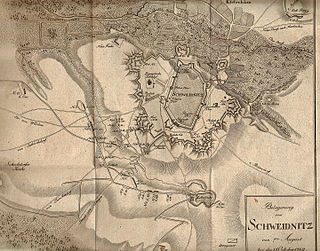
The siege of Schweidnitz took place between August and October 1762 during the Third Silesian War, part of the wider Seven Years' War. Prussian forces under the overall command of Frederick II laid siege to the city of Schweidnitz, in an attempt to retake it from an Austrian garrison.




















